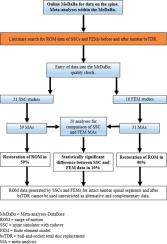Journal of Advanced Research ( IF 11.4 ) Pub Date : 2020-06-23 , DOI: 10.1016/j.jare.2020.06.017 Tobias Bohn 1, 2 , Susanne A J Lang 1 , Stephanie Roll 3 , Helene Schrader 1 , Matthias Pumberger 4 , Karin Büttner-Janz 1, 5

|
Background
Range-of-motion (ROM) data generated by the in vitro test methods of spine simulators with cadavers (SSCs) and finite element models (FEMs) are used alternatively and complementarily for in vitro evaluations.
Aim of Review
Our purpose is to compare exemplary segmental ROM data from SSCs and FEMs before and after ball-and-socket total disc replacement (bsTDR) to determine whether the two test methods provide the same data for the same evaluation subjects.
Key Scientific Concepts of Review
We performed 70 meta-analyses (MAs) and 20 additional comparative analyses based on data from 21 SSC studies used for 39 MAs and 16 FEM studies used for 31 MAs. Only fifty-nine percent (n = 23/39) of SSC MAs show a restored ROM after bsTDR, whereas in FEM MAs, the ROM is restored in ninety percent (n = 28/31). Among the analyses comparing data from the same spinal segments, motion directions and bsTDR, SSC and FEM data are significantly different in ten percent (n = 2/20). According to our results, data generated by SSCs and FEMs cannot be used as alternative and complementary data without restriction. The quality of the evaluation methods itself as well as potential technical reasons for the discrepant results were not our evaluation target. Further SSC and FEM data should be compared using the same approach.
中文翻译:

通过分析腰椎间盘置换前后的运动范围数据,比较脊柱模拟器与尸体和有限元模型的 Meta 分析
背景
由具有尸体 (SSC) 和有限元模型 (FEM) 的脊柱模拟器的体外测试方法生成的运动范围 (ROM) 数据可替代地和互补地用于体外评估。
审查目的
我们的目的是比较球窝全椎间盘置换 (bsTDR) 前后来自 SSC 和 FEM 的示例性分段 ROM 数据,以确定两种测试方法是否为相同的评估对象提供相同的数据。
审查的关键科学概念
我们基于用于 39 项 MA 的 21 项 SSC 研究和用于 31 项 MA 的 16 项 FEM 研究的数据,进行了 70 项荟萃分析 (MA) 和 20 项额外的比较分析。只有百分之五十九 (n = 23/39) 的 SSC MA 在 bsTDR 后显示恢复的 ROM,而在 FEM MA 中,ROM 恢复了百分之九十 (n = 28/31)。在比较来自相同脊柱节段的数据的分析中,运动方向和 bsTDR、SSC 和 FEM 数据在 10%(n = 2/20)中有显着差异。根据我们的结果,SSC 和 FEM 生成的数据不能不受限制地用作替代和补充数据。评估方法本身的质量以及差异结果的潜在技术原因不是我们的评估目标。进一步的 SSC 和 FEM 数据应使用相同的方法进行比较。











































 京公网安备 11010802027423号
京公网安备 11010802027423号